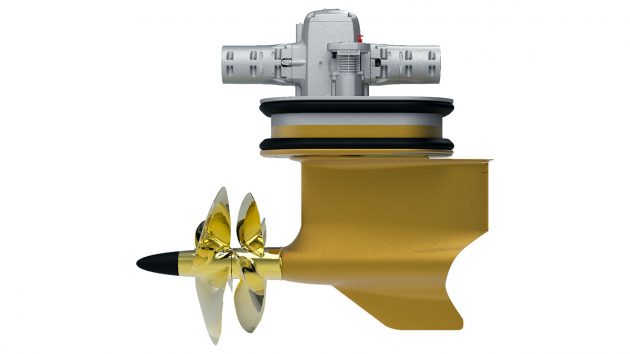A new pod drive system with two input shafts gives Volvo the power to propel larger craft using diesel engines, electric motors or both...
Until now Volvo Penta’s ability to power larger craft has been limited by the size of the engines in its portfolio. The most powerful of these is the 1,000hp IPS 1350, which when used in multiples of three or four can handle craft up to around 90ft but even then it eventually runs out of steam.
Now Volvo has come up with a new solution that not only doubles the size of craft it can handle (up to 55m) without increasing the size of its engines but offers a much wider variety of power sources, including diesel engines, electric motors or even a combination of both.
Volvo IPS 40: A hybrid solution
The secret to this breakthrough is a new IPS platform with two separate input shafts. Called IPS 40, it allows two different engines to be connected to a single, larger pod drive unit.
At a stroke this doubles the maximum power output available from a single pod drive installation from 1,000hp to 2,000hp but also makes it possible to mix and match power sources. The simplest option is to fit a pair of 1,000hp D13 diesel engines but twin electric motors or one diesel and one electric motor are also envisaged.
The latter is perhaps the most interesting idea as it offers a quick-fix solution for boat builders looking to add a hybrid diesel electric drivetrain to its range of larger craft. In all cases, the engines/motors are situated in line but on opposite sides of the pod, one in front and one behind, helping to keep the overall footprint as compact as possible.
Article continues below…

The future is hybrid: What this Volvo Beneteau collaboration means for boating

Pershing 140 yacht tour: Inside a 10,400hp, 38-knot monster superyacht
One of the many cited benefits is that by using two smaller engines instead of one bigger one, it will free up more space for guests and crew.
In fact because the D13s are relatively low by big boat standards and the IPS 40s can be installed further aft than traditional shaftdrive solutions, the entire drivetrain could be fitted under a yacht’s beach club or tender garage rather than in a separate engineroom amidships.
Speed and efficiency
The other big win of mounting the engines in line is that a twin-engined Volvo IPS 40 package is no wider than a single-engined IPS1350, meaning triple and even quad installations are possible.
That raises the intriguing prospect of superyachts powered by as many as eight engines driving four IPS pods and delivering speeds of 40 knots from a combined 8,000hp!
What makes all this possible is a clever new freewheeling hub on each input shaft. Like the hub on a bicycle wheel, this allows it to transfer drive to the gearbox when the engine or motor is running but spins freely as soon as it’s switched off or the other engine takes over.
It can also balance the load between the engines reducing the stress on each one during cruising and enabling a less powerful electric motor to act as the sole source of propulsion when manoeuvring in or out of port but also to deliver extra boost under acceleration once the diesel engine kicks in.
Even when fitted with two diesel engines the Volvo IPS 40 package still offers a number of claimed benefits over a single larger combustion engine.

Firstly, it is said to be more efficient, partly because of the reduced hydrodynamic drag of a pod drive over a conventional exposed shaft and p-bracket arrangement especially at higher speeds (Volvo reckons a 2,000hp IPS 40 will deliver the same performance as a 2,700hp shaft drive), but also because at lower speeds you can switch off one engine completely.
This not only saves any fuel being burnt in the unused engine but allows the remaining one to run closer to peak efficiency.
Reduced engine hours
The other win is that by alternating the use of both engines at lower running speeds, it will reduce the number of engine hours accumulated on each one, cutting servicing costs and extending warranty and rebuild intervals.
With a single bigger engine, all those hours are accrued on that engine, even when simply ticking along at idle speed. Volvo’s own data shows that most yachts this size spend at least 50% of the time running at low enough speeds for one of the two engines to power it.
The third possible benefit is the extra redundancy offered by having two engines on each pod – even if one fails, the other should still be able to get you home. Lastly, the smaller engines and superior damping of the through hull-mounted pod drives and exhausts make for a quieter drive with less vibration.
Volvo IPS 40 economies of scale
Volvo hasn’t yet released pricing for the new IPS 40 drives but with over 100,000 D13 engine blocks produced every year for its truck and marine divisions (the highest volume engine in its range), we’d like to think the economies of scale will enable it to offer a competitive alternative to higher powered MANs, MTUs and CATs when it comes to market in 2025.
After all, who doesn’t relish the idea of a Pershing 140 powered by eight 1,000hp engines?

The new IPS 40 can be fitted with twin D13s…

…twin electric motors…










